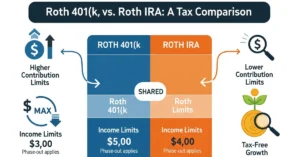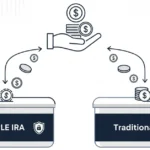Welcome to smartretireplans.com!
Deciding to roll over an old 401(k) or other retirement plan is a smart move toward consolidating your financial life. But once you’ve made that decision, a new question arises: “What is the best IRA rollover company?” With dozens of financial institutions vying for your business, finding the right fit can feel overwhelming.
The truth is, there is no single “best” company for everyone. The ideal choice depends entirely on your personal investment style, your level of experience, and what you prioritize in a financial partner. Are you a hands-off investor who wants a simple, low-cost option? Or are you an active trader who needs advanced tools and research?
This comprehensive guide will walk you through everything you need to know. We’ll break down the top IRA rollover companies, compare their features, and give you a clear roadmap for making the best decision for your financial future.
Understanding an IRA Rollover: The Basics
Before we dive into the companies, let’s quickly define what an IRA rollover is. A rollover is the process of moving funds from one retirement account (like an old 401(k) from a previous employer) into a new or existing Individual Retirement Arrangement (IRA).
The two main types of rollovers are:
- Direct Rollover (The Easiest Method): This is the most common and recommended method. Your old retirement plan administrator sends the funds directly to the new IRA provider. The check is made out to the new company “FBO” (For the Benefit Of) your name. This is the safest way to avoid any potential tax issues.
- Indirect Rollover (Handle with Care): In this method, the check from your old plan is made out to you. You then have 60 days to deposit that money into a new IRA. If you miss this deadline, the IRS will consider the withdrawal a taxable distribution, which could result in a hefty tax bill and a 10% early withdrawal penalty if you’re under age 59½.
For the purpose of this guide, we’ll assume you’re planning a direct rollover, as it’s the simplest and most secure option.
Key Factors to Consider When Choosing an IRA Rollover Company
Your choice of a rollover company will shape your retirement savings for years to come. Here are the most important factors to evaluate:
- Fees and Costs: This is often the most critical factor. Look for companies with no annual account maintenance fees, no transaction fees for common trades (stocks and ETFs), and low expense ratios on their mutual funds. Don’t forget to check for hidden fees like transfer-out fees if you ever decide to move your money again.
- Investment Options: Do you want to build your own portfolio with individual stocks and ETFs, or do you prefer a simple, all-in-one index fund? Some companies offer a wider range of investment choices, from bonds and mutual funds to even alternative investments.
- Customer Service and Support: The rollover process can sometimes be confusing. Having access to responsive, knowledgeable customer support is invaluable. Look for companies that offer 24/7 support, dedicated rollover specialists, and a smooth online experience.
- Tools and Education: Especially for new investors, a company with robust educational resources, calculators, and retirement planning tools can be a game-changer. These resources can help you build confidence and make more informed decisions.
- User Experience: A user-friendly website and a highly-rated mobile app can make managing your investments a breeze. An intuitive platform is essential, whether you’re a seasoned investor or just starting out.
- Robo-Advisor Services: If you prefer a completely hands-off approach, a company that offers a robo-advisor service can automatically manage your portfolio for a low annual fee.
With these factors in mind, let’s take a closer look at the top contenders for your IRA rollover.
The Top IRA Rollover Companies: A Detailed Breakdown
We’ve researched and evaluated the leading financial institutions to help you find the perfect home for your retirement savings.
1. Fidelity Investments: Best All-Around Choice
Fidelity is often considered the gold standard for IRA rollovers, and for good reason. It’s a financial giant with a reputation for being investor-friendly and offering a robust suite of services.
- Fees: Fidelity stands out for its commitment to low costs. It offers $0 account minimums and no account fees. The company is famous for its “Fidelity ZERO” index funds, which have a 0% expense ratio—an incredible benefit for long-term investors. They also offer commission-free trading for online stocks, ETFs, and options.
- Investment Options: The range of investment options at Fidelity is immense. You can trade stocks, ETFs, mutual funds (including thousands of no-transaction-fee funds), bonds, and even a selection of cryptocurrencies. This makes it suitable for every type of investor, from those who want a simple index fund to those who want a diversified, custom portfolio.
- Customer Service: Fidelity excels here, offering 24/7 customer support via phone, chat, and email. They also have an army of dedicated rollover specialists and hundreds of physical branches across the country for in-person assistance. Their online tools are also top-notch, with an easy-to-use “transfer status tracker” that lets you monitor the progress of your rollover.
- User Experience: While some users find the main website a bit old-fashioned, the overall platform is extremely feature-rich and powerful. The Fidelity mobile app is highly rated and makes managing your accounts on the go a breeze.
Pros:
- Zero-cost index funds: The Fidelity ZERO funds are a huge advantage.
- Excellent customer service: 24/7 support and dedicated rollover specialists.
- No account fees or minimums: Easy to get started.
- Wide range of investment options: Caters to all investor types.
Cons:
- The main website can feel a bit dated to some users.
- While they offer crypto, the selection is limited.
Best for: Everyone, especially beginners and investors who want a wide range of low-cost investment options and top-tier support.
2. Charles Schwab: Best for Investor Education and Research
Charles Schwab is a name synonymous with investor empowerment. It’s an excellent choice for those who value extensive research, powerful tools, and a customer-centric approach.
- Fees: Schwab, like Fidelity, is a low-cost leader. They offer $0 account minimums and no annual fees. Online stock and ETF trades are commission-free. Be aware, however, of a potentially high transaction fee on some non-Schwab mutual funds, which can be as high as $74.95.
- Investment Options: Schwab provides a vast selection of investment products, including thousands of mutual funds, ETFs, stocks, and bonds. They also offer robo-advisor services, like the Schwab Intelligent Portfolios, which manages your money for free (with a minimum of $5,000) but allocates a portion to cash, which some critics dislike.
- Customer Service: Schwab offers 24/7 customer service and has a strong reputation for being responsive and helpful. While some customer satisfaction reviews on third-party sites are mixed, many praise their commitment to assistance. They also have a network of physical branches.
- Tools and Education: This is where Schwab shines. Their educational resources are incredibly robust, with a huge library of articles, videos, and free coaching sessions on various investment topics. Their retirement planning tools, like the “Intelligent Income” tool, are top-of-the-line and help you plan your withdrawals in retirement.
Pros:
- Outstanding educational resources: Great for both new and experienced investors.
- Excellent research and planning tools: Helps you make informed decisions.
- Free robo-advisor service: A great hands-off option.
- Highly accessible customer support: 24/7 phone, chat, and email.
Cons:
- High transaction fees on some mutual funds.
- Mixed customer service reviews from some third-party sources.
- Lower interest rate on uninvested cash compared to some competitors.
Best for: Investors who want to be hands-on with their portfolio, value extensive research, and want access to a wealth of educational content.
3. Vanguard: Best for Low-Cost Passive Investing
Vanguard is a titan in the investment world, best known for pioneering low-cost index funds. If you’re a passive investor who wants a simple, buy-and-hold strategy, Vanguard is hard to beat.
- Fees: Vanguard is the undisputed champion of low fees. Their own index funds and ETFs have some of the lowest expense ratios in the industry. While they have no account minimums, be aware that many of their popular mutual funds have a minimum investment requirement of $3,000.
- Investment Options: The focus here is on simplicity and low costs. Vanguard offers a wide selection of their own highly-regarded index funds, mutual funds, and ETFs. While you can also trade individual stocks and ETFs, the platform is optimized for a passive, long-term investing approach.
- Customer Service: This is often cited as a weaker point for Vanguard compared to its competitors. While their support is available, it’s not as highly rated as Fidelity’s, and their website is sometimes seen as less user-friendly. Their focus is on keeping costs low, which means they invest less in these areas.
- User Experience: Vanguard’s website can feel less modern and more complex to navigate than platforms like Fidelity or Schwab. However, for a user who knows what they’re looking for (e.g., a Vanguard Total Stock Market Index Fund), it’s a straightforward process.
Pros:
- Extremely low-cost funds: Vanguard’s low expense ratios are a major long-term benefit.
- Passive investing focus: Ideal for a simple, buy-and-hold strategy.
- Trusted brand: A highly-respected name in the industry.
Cons:
- Customer service is not as robust as competitors.
- The website and user experience can feel dated.
- Many popular mutual funds have a $3,000 minimum investment.
- Less suited for active traders.
Best for: Long-term, passive investors who want a simple, low-cost portfolio of index funds and ETFs.
4. Betterment: Best for Hands-Off, Automated Investing
If you want to roll over your 401(k) and never think about it again, a robo-advisor like Betterment is an excellent choice. Betterment is a leader in automated investing, perfect for those who want a professional to manage their portfolio without the high cost of a human advisor.
- Fees: Betterment charges a flat, annual advisory fee of just 0.25% of your account balance. While this is a fee, it’s significantly cheaper than a traditional financial advisor. There are no trading commissions, transaction fees, or rollover fees.
- Investment Options: You don’t choose individual investments with Betterment. Instead, you answer a few questions about your risk tolerance and goals, and Betterment builds and manages a diversified portfolio of low-cost ETFs for you. They automatically rebalance your portfolio and offer a unique tax-loss harvesting feature to minimize your tax bill.
- Customer Service: Customer support is available via phone, email, and live chat. They also offer access to human financial advisors for an additional cost, which is a great option if you need personalized advice.
- User Experience: Betterment has one of the most user-friendly and modern platforms available. Their website and app are clean, intuitive, and designed to make investing simple and transparent. The rollover process is also highly streamlined.
Pros:
- Truly hands-off investing: Automated portfolio management and rebalancing.
- Low annual advisory fee: Much cheaper than a human financial advisor.
- Tax-loss harvesting: An advanced tax-saving feature.
- Excellent user experience: Modern, simple, and easy to use.
Cons:
- Limited investment control: You can’t choose individual stocks or funds.
- The annual fee, while low, is a continuous cost that some investors want to avoid entirely.
- Requires a higher level of trust in their algorithm.
Best for: Investors who want a simple, automated, and hands-off approach to their retirement savings.
Comparison Table
| Feature | Fidelity Investments | Charles Schwab | Vanguard | Betterment |
| Account Fees | $0 | $0 | $0 | $0 |
| Advisory Fee | $0 (Self-directed) | $0 (Self-directed) | $0 (Self-directed) | 0.25% annual fee |
| Online Stock/ETF Trades | $0 commission | $0 commission | $0 commission | Not applicable |
| Investment Options | Wide range (stocks, ETFs, mutual funds, etc.) | Wide range (stocks, ETFs, mutual funds, etc.) | Strong focus on Vanguard funds | Pre-built ETF portfolios |
| Customer Service | 24/7 phone, chat, in-person branches | 24/7 phone, chat, in-person branches | Phone, but less robust | Phone, email, live chat |
| Rollover Process | Easy, with a dedicated tracker | Easy, with specialists available | Generally simple, but less streamlined | Highly streamlined and easy |
| Best For | All-around investors, beginners | Educational resources, research | Passive, low-cost investors | Hands-off, automated investing |
A Step-by-Step Guide to Your IRA Rollover
Once you’ve chosen the right company, the rollover process is fairly straightforward.
- Open a Rollover IRA: The first step is to open a new rollover IRA account with the company you’ve chosen. This can be done online in just a few minutes.
- Contact Your Old Provider: Call the administrator of your old 401(k) or retirement plan and tell them you want to initiate a rollover.
- Request a Direct Rollover: Be very clear that you want a direct rollover. The old provider will then send a check directly to your new IRA provider, made out to the new company “FBO [Your Name].”
- Wait for the Funds: The process typically takes 2-4 weeks. If you’re using a company like Fidelity, you can track the status of the transfer online.
- Invest Your Money: Once the funds arrive, they will be deposited into a money market or cash account. The final, and most important, step is to log into your new account and choose the investments you want to buy.
Final Thoughts: What is the Best IRA Rollover Company?
Choosing the best IRA rollover company is a personal decision. If you value a powerful platform with a massive range of options, Fidelity is a fantastic choice. If you’re a meticulous planner who loves to do your own research, Charles Schwab could be the perfect fit. If you want the lowest-cost passive investing available, Vanguard remains the king. And if you simply want to set it and forget it, a robo-advisor like Betterment is an excellent, stress-free option.
Take your time, consider your priorities, and choose the company that aligns best with your retirement goals. This single decision can simplify your financial life and put you on the fast track to a secure and comfortable retirement.
FAQ
What is an IRA rollover?
An IRA rollover is the process of moving funds from one retirement account, such as an old 401(k) from a previous employer, into a new or existing Individual Retirement Arrangement (IRA). This allows you to consolidate your retirement savings and take control of your investments.
What’s the difference between a direct and an indirect rollover?
In a direct rollover, your old plan administrator sends the funds directly to your new IRA provider. This is the safest and most recommended method, as the money never passes through your hands and you avoid any tax issues. An indirect rollover is when the funds are sent to you personally, and you then have 60 days to deposit the money into a new IRA. If you miss this deadline, the withdrawal will be considered a taxable event, and you could face taxes and penalties.
Can I roll over my old 401(k) into a Roth IRA?
Yes, you can. However, this is considered a Roth conversion. The money you are moving from your traditional 401(k) was contributed on a pre-tax basis, so you will have to pay income tax on the entire amount you convert in the year of the rollover. This can be a smart move if you expect to be in a higher tax bracket in retirement.
How much does an IRA rollover cost?
The cost of an IRA rollover itself is typically free with most top companies like Fidelity, Schwab, and Vanguard. However, your old 401(k) plan administrator may charge an administrative fee for processing the transfer, which can range from a small fee to over $100. Be sure to check with your old provider before initiating the rollover.
How long does an IRA rollover take?
The rollover process typically takes about 2 to 4 weeks, but the timeline can vary. The direct rollover method is usually faster and more secure. Some companies, like Fidelity, provide a tracking tool that allows you to monitor the status of your transfer online.














